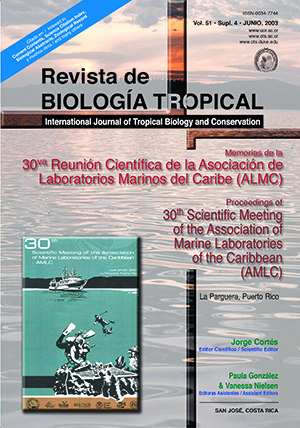Resumen
Esta investigación expresa el potencial de la actividad antibacteriana presente en los extractos orgánicos obtenidos de Penicillium sp. aislado de la esponja Ircinia felix. Esta actividad fue evaluada mediante la prueba de difusión en agar y la concentración mínima inhibitoria (CMI). Las pruebas de susceptibilidad fueron realizadas frente a Staphylococcus aureus, S. epidermidis, Bacillus cereus y B. subtilis. El empleo de las técnicas cromatográficas (CLV y TLC), permitieron la obtención de extractos orgánicos bioactivos de diferentes polaridades, de los cuales sólo las fracciones EtOAc y MeOH inhibieron el crecimiento de los organismos ensayados. Del fraccionamiento del extracto EtOAc sólo la fracción 3 EtOAc /Hex presentó la mayor actividad frente a las bacterias Gram-positivas. La subfracción 1 (sf1) EtOAc/Hex incrementó su actividad frente a S. aureus (24 mm) y S. epidermidis (25 mm), comportamiento que podría ser explicado por la anulación de un posible efecto antagónico durante el proceso de fraccionamiento. Las pruebas de CMI realizadas a sf1 EtOAc/Hex frente a S. aureus, S. Epidermidis, B. cereus y B. subtillis resultaron de importancia clínica, lo cual demuestra el gran potencial de este extracto orgánico como agente antibacteriano.Citas
Alam, M., E.B. Gareth, M.B. Hossain & D. van der Helm. 1996. Isolation and structure of isoculmorin from the marine fungus Kallichroma tethys. J. Nat. Prod. 59: 454-456.
Bauer, A., W. Kirby, I. Sherris & M. Turk. 1966. Antibiotic susceptibility testing by standardized single disk method. Am. J. Clin. Pathol. 45: 493-496.
Coll, J.C. & B.F. Bowden. 1986. The aplication of vacuum liquid chromatography to the separation of terpene-mixture. J. Nat. Prod. 49: 934-936.
Delgado, A., S. Amich, S. Pietro & M. Salve. 1994. Laboratorio clínico de microbiología. McGraw Hill, Madrid. 593 p.
Domsch, K.H. & W. Gams. 1980. Compendium of soil fungi. Academic, London. 1985 p.
Fauci, A.S., E. Brauunwald, K.J. Isselbacher, J.D. Wilson, J.B. Martin, D.L. Kasper, & L. Longo. 1998. Harrison: Principios de Medicina Interna. McGraw-Hill, México D.F. 2941 p.
Faulkner, D.J. 1994. Production of bioactive metabolites by symbiotic microorganisms in marine sponges. J. Nat. Prod. 35: 22.
Hardman, J.G., L.E. Limbird, P.B. Molinoff, R.W. Ruddon & A.G. Gilman. 1996. Las bases farmacológicas de la terapéutica. McGraw-Hill, México DF. 1907 p.
Hay, M.E. & W. Fenical. 1996. Chemical ecology and marine biodiversity: Insight and products from the sea. Oceanography 9: 10-20.
Katzung, B. 1987. Farmacología básica clínica. El Manual Moderno, México, DF. 591 p.
Kobayashi, H., M. Naminoshi, T. Yoshimoto & T. Yokochit. 1996. A screening method for antimicotic and antifungal sustance using conidia of Pyricularia oryzae. Modification and application to tropical marine fungi. J. Antibio. 491: 573-879.
Köning, G.M. & A.D. Wright. 1995. Marine natural products research: current directions and future potencial. Plant. Med. 62: 193-211.
McCaffery, Y. and J. Endean. 1985. Antimicrobial activity of tropical and subtropical sponges. Mar. Biol. 89: 1-8.
Morales, T., J. Cubero, Z. Lanz, Y. Gómez-Guiñán & M.I. Segnini-Bravo. 2000. Actividad antimicrobiana de extractos orgánicos aislados de Aplysina fistularis (Demospongiae: Aplysinidae). Rev. Biol. Trop. 48 (Supl. 1): 199-206.
Pelletier, S.W. 1986. Separation of diterpenoid, alkaloid mixture using vacuum liquid chromatography. J. Nat. Prod. 49: 892-900.
Rios, J.L., M.C. Recio & A. Villar 1988. Screening methods for natural products with antimicrobial activity: a review of the literature. J. Ethnopharmacol. 23: 127-149.
Sheuer, P.J. 1986. Marine natural products. Chemical and biological perspectives. Academic, New York. 503 p.
Stainer, R.Y., E.A. Adelberg & J.I. Ingrahan. 1984. Microbiología. Reverte, Barcelona. 836 p.
Thakur, N.L. & A.C. Anil. 2000. Antibacterial activity of the sponge Ircinia ramosa. Importance of its surfaceassociated bacteria. J. Chem. Ecol. 26: 57-71.
Thompson, D.P. & C. Cannon. 1986. Toxicity of essential oils on toxigenic and nontoxigenic fungi. Bull. Eviron. Cont. Toxicol. 36: 527-532.
Toske, S.G., P.R. Jensen, C.A. Kauffmam & W. Fenical. 1998. Aspergillamides A and B: Modified cytotoxic tripeptides produced by a marine fungus of the genus Aspergillus. Tetrahedron 54: 13459-13466.
Touchstone, J. 1992. Practice of thin layer chromatography. Wiley, New York. 700 p.
##plugins.facebook.comentarios##

Esta obra está bajo una licencia internacional Creative Commons Atribución 4.0.
Derechos de autor 2003 Revista de Biología Tropical


